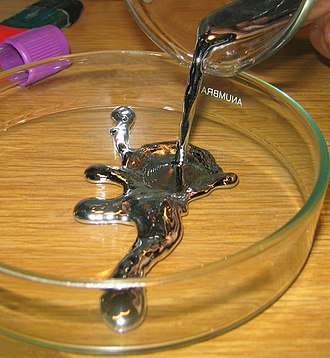 |
| 19th century hat makers often suffered from mercury poisoning |
Mercury is a liquid at room temperature (which seemed really cool to me as a kid.) But that liquid easily vaporizes into the air around it. Breathing that air can poison you. Who knows how many of us destroyed brain cells by breaking a fever thermometer to play with the liquid inside when we were curious (and naughty) children?
The metal is usually found in deposits of something called cinnabar (mercuric sulfide). The red pigment called vermilion is made of ground cinnabar.
Alice in Wonderland’s Mad Hatter was inspired by real 19th century hat makers who “went mad” with a form of mercury poisoning. It was caused by a mercury compound used in processing felt. (Although the Mad Hatter doesn’t actually show any signs of mercury poisoning.)
Uses of Mercury
Luckily, mercury is no longer used in felt, and other industries are phasing it out of use. Mercury filled fever thermometers were outlawed in the US in 2002 for over-the-counter sales
It was also in use for many years for dental fillings. I know I’ve got some.
Mercury vapor is still a very important component of fluorescent lighting. When electricity passes through mercury vapor, it produces short-wave ultraviolet light which causes the phosphor in the tube to “fluoresce” and create light.
Compounds of mercury are still found in some over-the-counter drugs, including topical antiseptics (especially as Mercurochrome.) It’s also still used in stimulant laxatives, diaper-rash ointment, eye drops, and nasal sprays. It can also be found in cosmetics, like mascara. (In 2008, Minnesota became the first US state to ban the use of mercury in cosmetics.)
 |
| The only metal that's liquid at room temperature |
Mercury is also a byproduct of a number of industrial processes, such as burning coal. Vaporized mercury from coal burning can make its way into soil and water, where it poses a risk to plants, animals, and humans.
The Three Forms of Mercury
Mercury can be found in three forms:
#1 Elemental mercury. That’s the one in glass thermometers. It’s not harmful if touched, but can be lethal if you inhale the vapor it emits.
#2 Inorganic mercury is the kind of mercury used to make batteries. It’s deadly if you eat it.
#3 Organic mercury known as methylmercury, is the kind found in fish that are high on the food chain, like tuna and swordfish. (consumption should be limited to 170g per week). It can be deadly when ingested over long periods of time, because it builds up in the system. Methylmercury is highly toxic and it forms when mercury dissolves into the water.
High level exposure to methylmercury is known as Minamata disease.
 |
| Qin Shi Huang |
Mercury in History
Ancient people all over the world seem to have been as fascinated by mercury as I was as a child.
China’s first emperor, Qin Shi Huang, believed that mercury could give everlasting life and managed to cut his own life short by drinking a mixture of mercury and powdered jade while aiming for that immortality thing.
The ancient Maya and other pre-Colombian peoples were also enamored of mercury and large quantities of it have been found in Mayan ruins and the pyramids at Teotihuacan.
In Ancient Egypt and Rome, cinnabar was used as a cosmetic, and the ancient Greeks used it as an antiseptic.
In Moorish Spain, it was used to make stunning reflective pools.
Mercury in Medicine
 |
| Did Mozart die of mercury poisoning? |
Mercury compounds have also been used since ancient times as a medicine. Chinese traditional medicine uses cinnabar to treat a number of ailments.
Mercuric chloride was used from the 17th-19th centuries to treat syphilis, although it is so toxic that sometimes the symptoms of its toxicity were confused with those of the syphilis it was believed to treat.
Many people believe Wolfgang Amadeus Mozart died of mercury poisoning from the medicine he took to treat his syphilis.
Mercuric chloride and a mercury-honey syrup called “Blue Mass” were prescribed throughout the 19th century for a whole bunch of conditions including constipation, depression, and toothaches.
Abraham Lincoln took Blue Mass to treat constipation. He may also have hoped it would treat his depression.
In the early 20th century, people gave their children a mercury compound as a laxative (and dewormer.) It was even used in teething powders for infants.
 |
| Mercurochrome contains mercury, but not chrome |
We used it as topical antiseptic for minor cuts and scrapes. It's now banned in the US, but still widely used elsewhere.
Symptoms of Mercury Poisoning
Mercury affects the nervous system, leading to neurological symptoms:
- anxiety
- irritability
- numbness
- memory problems
- depression
- physical tremors
- muscle weakness
- metallic taste in the mouth
- nausea and vomiting
- loss of motor skills
- numbness in the hands, face, or other areas
- loss of vision, hearing, or speech
- difficulty breathing
- difficulty walking or standing straight
- kidney failure
- decrease in cognitive ability.
Treatment
There’s no standard cure for mercury poisoning. Eliminating risk factors by making changes in diet and work or living environment may help reduce the levels of mercury so people can recover.
Besides elimination of sources of exposure, severe cases of mercury poisoning can be treated with chelation therapy.
The drugs used in chelation therapy bind to heavy metals in the bloodstream so they can be eliminated. But chelation therapy comes with its own risks and side effects, so doctors use this kind of medication only when it’s absolutely necessary.
Mercury: The Perfect Murder Weapon?
 |
| Mercury poisoning is a "zebra diagnosis" |
People suffering from depression sometimes attempt suicide with mercury. That usually turns out to be a bad idea on many levels because the poison is so slow-acting.
One man took a large dose of mercury that ended up accumulating in his appendix. An appendectomy plus chelation cured him and he was sent home from the hospital three weeks later. (I couldn’t find out if there was enough residual poison to kill him eventually.)
There aren’t many reports of deliberate murder by mercury poisoning. That’s probably because the symptoms are cumulative and can also be ascribed to many more common diseases.
Heavy metal poisoning is a considered “zebra” diagnosis. It’s so rare that most doctors don’t consider it. (The “zebra” comes from an old saying used in teaching medical students: 'When you hear hoofbeats, think of horses, not zebras.')
I found one case of a woman murdered by mercury poisoning, which wasn’t diagnosed until six years after her death.
This would make mercury an ideal murder weapon for a mystery novel. It’s slow acting, has few symptoms early on, and most doctors would never consider it as a cause of death.
What about you? Have you ever read a mystery novel where mercury was used as a poison? Do you know of any real-life situations where mercury was suspected in a deliberate poisoning?
Here's a List of All the Posts in the Poison Series
Part 28: Mustard Gas
Part 29: Antimony
Part 30: Lead
Part 31: Opium Poppy
BOOK OF THE MONTH
I started this blog to test out my theories about author blogs. Posting once a month, I've managed to keep it in Google's good graces, with an Alexa rank under 2 million 347K in the US. Slow blogging works!
The Author Blog: Easy Blogging for Busy Authors is now in paperback!

And the ebook is only $2.99 until the end of the month
at Nook, Kobo, Apple, and Amazon.
Also available at Scribd, Playster, 24 Symbols
Part 29: Antimony
Part 30: Lead
Part 31: Opium Poppy
BOOK OF THE MONTH
I started this blog to test out my theories about author blogs. Posting once a month, I've managed to keep it in Google's good graces, with an Alexa rank under 2 million 347K in the US. Slow blogging works!
The Author Blog: Easy Blogging for Busy Authors is now in paperback!

And the ebook is only $2.99 until the end of the month
at Nook, Kobo, Apple, and Amazon.
Also available at Scribd, Playster, 24 Symbols
No comments:
Post a Comment